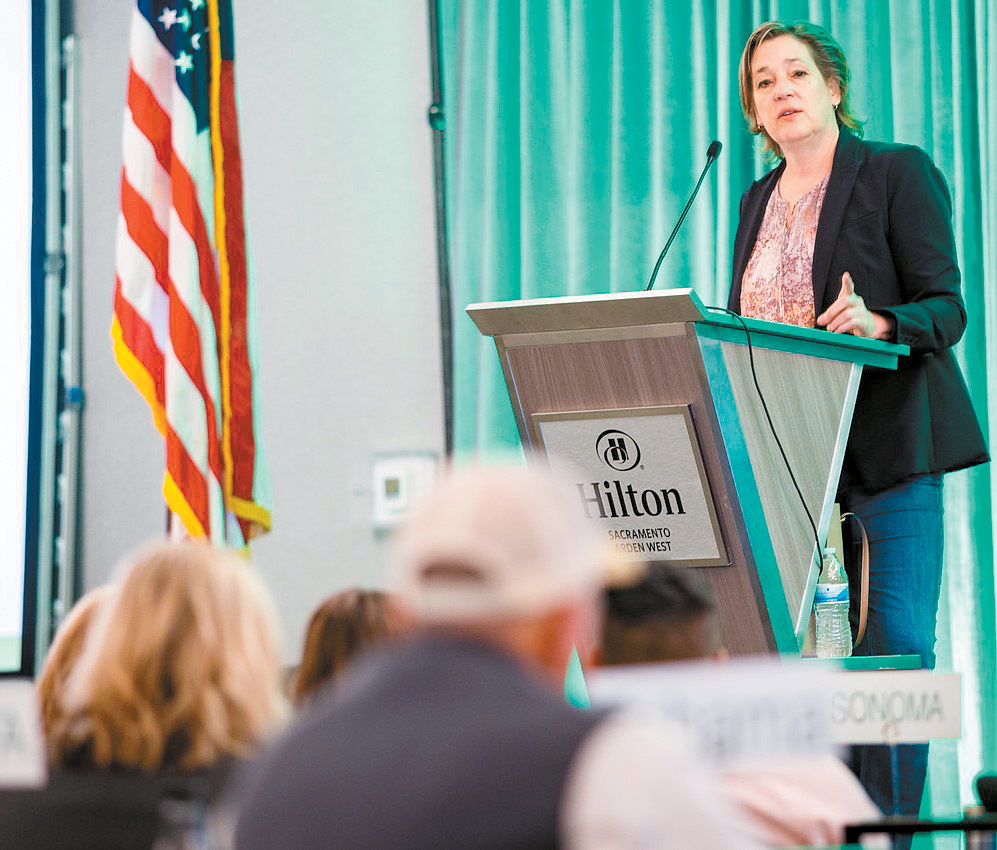State works to better adapt to extreme dry, wet periods

California Department of Water Resources Director Karla Nemeth speaks at the California Farm Bureau Capital Ag Conference.
Photo/Matt Salvo

By Ching Lee
As California farmers struggle through impacts of rapid swings between intense drought and severe deluge, the state’s water chief emphasized the need to better manage flood flows and groundwater during wet periods to improve water supply reliability during dry periods.
Karla Nemeth, director of the California Department of Water Resources, highlighted some of the work already underway during the state’s weather whiplash in recent years. She also outlined long-term plans to help the state adapt more broadly.
Nemeth spoke during the California Farm Bureau Capital Ag Conference in Sacramento last week. (See related story, Page 1.)
With reduced surface water supplies during the drought and implementation of the Sustainable Groundwater Management Act limiting groundwater pumping, California farms faced “dual pressures” that threatened their survival, Nemeth said. She also acknowledged that investments in water infrastructure—which farmers have urged for years—have been slow coming.
The atmospheric river storms that pummeled California in 2023 provided relief from the multiyear drought. The big rain events also tested how the state responded as it went from the driest three years on record to the wettest three weeks on record, Nemeth said.
Working with the state Water Resources Control Board and the U.S. Bureau of Reclamation, DWR managed to divert floodwaters and start recharging groundwater basins. Nemeth said the department learned a lot about how to streamline permitting and used tools such as satellite data to map out the best places for groundwater recharge. As a result, the San Joaquin Valley saw “incredible rebound of groundwater basins,” with 300,000 acre-feet of groundwater recharged on the west side, she noted.
“It was a really important moment for us to roll up our sleeves and work directly with growers in the irrigation districts and flood agencies to figure out how do we get this project in the ground out on this timeline to take advantage of these storm events,” Nemeth said.
Impacts of climate change and rising temperatures mean more of the state’s water supply will come as rain rather than snow, with Southern California experiencing drier conditions over time and big pulses of water coming from more tropical storms, she said. The state’s challenge, she added, is capturing that water with its existing water infrastructure and technology.
“Tools helping us understand water supply availability is going to be huge,” Nemeth said. They include aerial snow observations that measure snow water and implementation of forecast-informed reservoir operations, which maintain flood space in reservoirs by releasing water at a particular pace as storms come in. Such strategies improve flood protection and the ability to store water, she said, and are “generating real results.”
With the 10-year anniversary of the passage of SGMA, Nemeth said the state still must address land subsidence, particularly in the Central Valley, or “run into a lot of roadblocks” if it wants taxpayers to fund rehabilitation without having adequately arrested the problem.
In operating the State Water Project and the Central Valley Project, DWR and the U.S. Bureau of Reclamation must continue to comply with state and federal laws that protect endangered and threatened species, such as chinook salmon.
Nemeth said the department is using new genetic technology to help manage endangered species protection. Use of environmental DNA testing, she said, allows DWR to identify protected fish more accurately at pumping facilities. This is important because only winter-run and spring-run chinook salmon are protected. Before genetic testing, the old approach sometimes led to misidentification of the type of juvenile salmon, potentially triggering mandatory pumping restrictions. The improved accuracy of the genetic tests prevents unnecessary reduction in water capture.
Looking to the future and how the state manages weather extremes and their impacts on water supply, Nemeth said she thinks forecasting improvements, along with monitoring and understanding the availability of snowmelt over time, will be key. Forecast-informed reservoir operations and reinvestment in the CVP and the SWP are also part of the “big picture,” she said.
A revised version of the California Water Plan, which is updated every five years, was released in September. The updated plan places “heavy emphasis on watershed scale management and how we bring both groundwater agencies and flood management agencies more fully into the water planning process, because that kind of watershed scale integration is where the solutions lie,” Nemeth said.
San Bernardino County farmer Scott Hudson asked Nemeth about the long-term prospects of water companies that buy water from Northern California for groundwater recharge projects but also increasingly to expand housing.
Even though they may not be popular for everyone, Nemeth said she thinks water trading from the North State to regions where water is less abundant is here to stay. There is more precipitation in the north, she noted, and “we do have housing needs and housing goals too, and those homes need to be served.”
She said she thinks the agricultural community and urban water users need to fully explore more flexibility in long-term water transfers that help generate revenue, which supports investment in infrastructure that makes those transfers possible.
“I am very much in favor of improving the flexibility of the transfer market,” Nemeth said. “We are going to have some opportunities if we have the right infrastructure to move that water out and to engage the transfer market.”
There are also opportunities for other types of investments, including water recycling, ocean desalination and brackish water desalination, she said.
Norm Groot, executive director of Monterey County Farm Bureau, asked Nemeth about costs associated with SGMA. He noted DWR approved six groundwater sustainability plans in the region that identified nearly $600 million worth of projects that include brackish water desalination. But cost of those projects could balloon to a billion dollars in the next 14 years, he pointed out.
“That’s going to be a daunting task to fund that,” Groot said. “We’re really looking at how do we do that without bankrupting our communities and causing economic havoc within our communities.”
Nemeth said there will be economic impact in implementing sustainability plans, and “there aren’t any silver-bullet answers.” Projects that can demonstrate benefits to public safety, the environment and fish will have the best chance of getting funded, she said.
She also acknowledged the need for a funding plan that “looks at what communities can sustain, such as through pumping fees and property taxes,” with support from state and federal dollars.
“There are opportunities there,” Nemeth said. “How we pull them together just needs a lot of work, and I would recommend that you continue to voice that to our groundwater management folks because we talk a lot about what the solution sets are, including funding.”
(Ching Lee is an assistant editor of Ag Alert. She may be contacted at clee@cfbf.com.)




